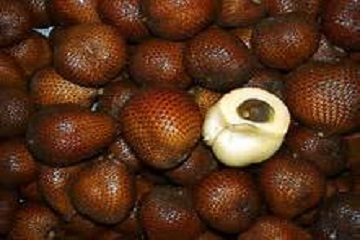A Group of IPB Students Created Dried Salak Fruit Snacks

Indonesia is an agro-based country with tropical climate suitable for growing various horticultural crops including tropical fruits and vegetables. Fresh fruit and vegetables have always made up a significant portion of the Indonesian diet which in the past consisted of locally grown produce purchased from traditional retail outlets and markets. According to the Directorate General of Horticulture (2009), the production of Indonesian fruits increases from year to year. Production of fruits in 2007 reached 17 million tons, an increase compared to 2006 production of about 16 million tons and in 2005 of 14.7 million tons, but unfortunately fruit that grows untapped. Indonesian fruit consumption is also very low. This may be caused by various factors, one of which is the lack of public awareness about the importance of eating fruits and vegetables.
People typically eat both fresh and processed vegetables and fruits. Assuring the safety and quality of fresh-cut produce necessitates the selection of high quality horticultural produce for processing, and the implementation of good practice during processing operations in order to maintain produce quality and assure safety of the final product. Some of which have to be preserved. Food drying is one of the oldest methods of preserving food for later use but still retains its flavour and aroma. It can either be an alternative to canning or freezing, or compliment these methods. Drying foods is simple, safe and easy to learn. With modern food dehydrators, fruit leathers, banana chips and beef jerky can all be dried year round at home. Currently dried fruit consumption is widespread, some are even ready for export, for international market. Demand for dried fruits continues to increase as the people of developed countries like foods which are rich in different types of dietary fiber. Based on data from the Ministry of Agriculture, exports of dried fruit reached 16 million kg with a value of US $ 3,282,041 in 2005.
Food drying is one of the oldest methods of preserving food for later use. Drying removes the moisture from the food so bacteria, yeast and mold cannot grow and spoil the food. To prolong their availability on the market, drying has received special attention as currently this method is considered one of the most common ways for obtaining food products from natural sources. The solution for preserving problem is offered by five students of the Faculty of Agricultural Technology of Bogor Agricultural University (FATETA IPB). They consists of Novi Kurnianto, Muhammad Afif Sulthoni, Jeffry Al Bukhori, Mohammed Rizki Marhaban, and Fakhri Ramadian Hidayat. One of the solutions to produce dried fruits that can be converted back into fresh fruit. We can rehydrate dried fruit by simply reversing the dehydration process: soak it in water to refresh. So consumers will have fresh fruit again. This methods will improve the distribution sytem of fruit, thus allowing the farmer to have easier access to them.
Under the sponsorships of Program Kreativitas Mahasiswa (PKM-P Student Creativity Program), Novi with other four colleagues implemented the study program on Drying Preserves Food or rehydration of Salak (Salacca zalacca) is one of the favored fruit plants and has good prospects to cultivate. Salak fruit, more technically known as snake a fruit that grows in clusters at the base of the palm and they are called snake fruit because of its reddish-brown scaly skin.. The superiority of salak fruit has a fairly high nutritional content.
Salak scientifically called Salacca zalacca is a fruit native to south Sumatra and southwest Java as well as other parts of the world and belongs to the Arecaceae family. It is cultivated in other regions as a food crop, and reportedly naturalized in Bali, Lombok, Timor, Malaysia, Maluku and Sulawesi. The fruits grow in clusters at the base of the palm, and are also known as snake fruit due to the reddish-brown scaly skin but the inside is sweeter than honey, sour like a pineapple and incredibly juicy. Its flesh is slightly acidic, giving your tongue a citrus like tingle. Therefore, innovations are made to allow the salak to be preserved for longer periods while still maintaining its nutritional value. Salak fruit consist of nutrition just like Protein, Beta-Carotene, Vitamin-C, Dietary fiber, Iron, Calcium, Phosphorus and Carbohydrates which are great for overall health. Salak or Snake Fruit contains lots of Beta-Carotene which is a powerful antioxidant and works well to prevent cardiovascular disease, strokes, and even cancer. In addition, the wider community can also enjoy the dried fruits for its nutritional contents, said Novi. (Wied)



